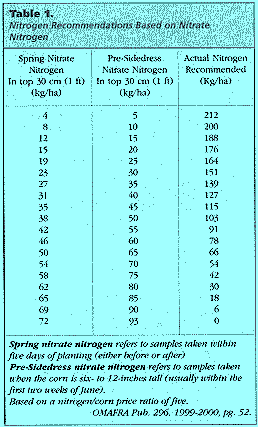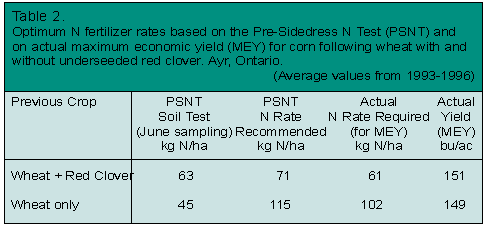The
Pre-Sidedress Nitrogen Test for Corn
By
Greg Stewart, OMAFRA Corn Specialist
Background
Historically, nitrogen recommendations for corn have been based on yield potential.
As yield expectations increased, so did the amount of recommended nitrogen.
However, research has indicated that on many fields the relationship between
nitrogen requirements and actual yield is often weak. Environmental and economic
concerns prompted a revamping of nitrogen recommendation procedures. The most
dominant of these new approaches was to conduct soil nitrate testing in the
spring. The logic? Determining the amount of available nitrate-nitrogen in the
soil would surely be a superior indicator of the amount of nitrogen fertilizer
required to produce maximum economic yields.
A few years ago, a soil nitrate-nitrogen test (planting-time sampling only)
was introduced in Ontario. This year, OMAFRA Publication 296 includes an updated
version of this test with the option for a pre-sidedress sampling approach.
Planting Time
versus Pre-Sidedress
A large percentage of nitrogen fertilizer is applied at planting time in Ontario.
It was thought that any testing procedure would need to involve soil sampling
in this time period, then turn the results around quickly so that producers
could adjust broadcast nitrogen applications at planting, to reflect the soil
test results.
This approach faced predictable problems. For many corn producers, there was
simply not enough time during this plantingperiod to consider adding the additional
workload of soil testing and last-minute adjustments to nitrogen applications.
As well, in situations where manure had been applied the previous year or where
red clover or alfalfa had been plowed down, the test was unreliable. Early spring
soil temperatures are often too low for the nitrogen from these organic sources
to be converted to nitrate, so the test missed giving the proper credit.
The new option for producers is to perform soil sampling in the early part of
June, before sidedress applications of nitrogen. This approach responds to both
of the previously outlined concerns by giving producers a bigger window of opportunity
to conduct the soil test and allowing for soils to warm up so that more accurate
assessments of available
soil nitrogen can be made. The procedure for conducting these pre-sidedress
nitrogen tests is outlined in OMAFRA publication 296 (1999/2000 edition). Table
1 is from this publication and outlines how producers can adjust nitrogen applications
based on either spring (sampling five days either side of planting) or pre-sidedress
(sampling generally in the first two weeks of June) soil nitrate-nitrogen testing.
Will It Work?
The pre-sidedress nitrogen
test has positioned itself as being easier to manage. But the big question is
still to be answered. Will it work? That is, will this approach significantly
enhance corn producers ability to predict nitrogen requirements to reach maximum
economic corn yields. Research results from the University of Guelph (Dr. Tony
Vyn and Ken Janovicek) have shown considerable support for the use of the pre-sidedress
N test (PSNT). Table 2 illustrates the potential reliability of the PSNT on
studies conducted on sandy loam soils near Ayr. The plots in this study were
fall-plowed wheat or wheat/red clover and then planted into corn. Corn plots
were fertilized with various N rates to determine the actual nitrogen requirements.
Often recommendations obtained from the PSNT were closer to the actual requirements
than yield-goal based estimations with assumed nitrogen credits for the red
clover.
Conclusions
The PSNT holds real potential
for improving nitrogen recommendations for corn. If you have pre-sidedress capabilities
or access to them, it is a management tool worth considering. No doubt there
will be further refinements to soil testing for nitrogen and these may include
adjusting for the variability imposed by topography, soil organic matter, etc.
Meanwhile, producers growing corn particularly in cropping systems which include
fall-applied manures, plowed-down red clover or alfalfa, or those with a history
of high fertility need to make sure their nitrogen applications are cost effective.
On these fields, where a reduction in nitrogen fertilizer is warranted, the
PSNT can help you zero-in on the most efficient N rate. The odds are good that
on at least some of your land, you can use the results from PSNT to make profitable
adjustments to sidedress nitrogen applications.
Back
to Top


